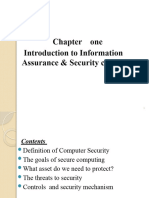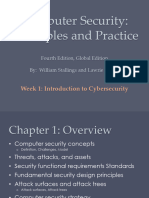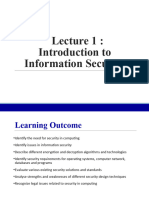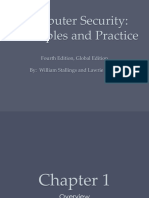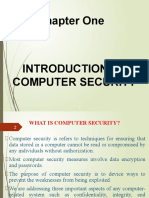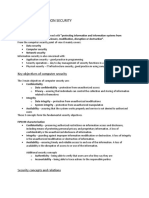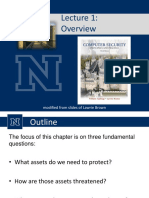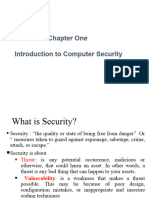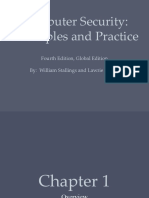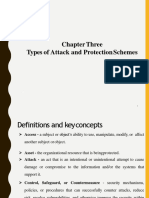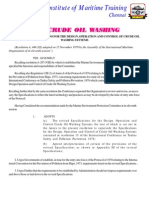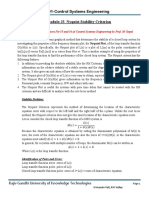05/09/2017
Lecturer: Nguyễn Thị Thanh Vân – FIT - HCMUTE
Describe the key security requirements of confidentiality,
integrity, and availability.
Discuss the types of security threats and attacks that must be
dealt with and give examples of the types of threats and
attacks that apply to different categories of computer and
network assets.
Summarize the functional requirements for computer security.
Explain the fundamental security design principles.
Understand the principle aspects of a comprehensive security
strategy.
05/09/2017 2
1
� 05/09/2017
The protection afforded to an automated information
system in order to attain the applicable objectives of
preserving the
o integrity,
o availability, and
o confidentiality
of information system resources, includes:
o hardware,
o software,
o firmware,
o information/data, and
o telecommunications).
05/09/2017 3
05/09/2017 4
2
� 05/09/2017
Attack - an act that is an intentional or unintentional attempt to cause damage
or compromise to the information and/or the systems that support it.
Threats - a category of objects, persons, or other entities that represents a
potential danger to an asset.
Threat Agent -a specific instance or component of a more general threat
Vulnerability- weaknesses or faults in a system or protection mechanism that
expose information to attack or damage
Hacking - Good: to use computers or systems for enjoyment; Bad: to illegally
gain access to a computer or system
Risk - the probability that threat will exploit a vulnerability with a harmful result.
Subject - an active entity that interacts with an information system and causes
information to move through the system for a specific end purpose
Object - a passive entity in the information system that receives or contains
information
Access - a subject or object’s ability to use, manipulate, modify, or affect
another subject or object
Asset - the organizational resource that is being protected.
Control, Safeguard or Countermeasure- security mechanisms, policies or
procedures that can successfully counter attacks, reduce risk, resolve
vulnerabilities, and otherwise improve the security within an organization
Exploit – to take advantage of weaknesses or vulnerability in a system
Exposure - a single instance of being open to damage.
Security Blueprint - the plan for the implementation of new security
measures in the organization
Security Model - a collection of specific security rules that represents the
implementation of a security policy
Security Posture or Security Profile- a general label for the combination of
all policy, procedures, technology, and programs that make up the total
security effort currently in place
6
3
� 05/09/2017
05/09/2017 7
Vulnerabilities
o It can be corrupted, so that it does the w rong thing or gives w rong answ ers.
o It can become leaky.
o It can become unavailable or very slow.
Attacks
o Active attack: An attempt to alter system resources or affect their operation.
o Passive attack: An attempt to learn or make use of information from the system
that does not affect system resources.
o Inside attack: Initiated by an entity inside the security perimeter, it is authorized
to access system resources but uses them in a w ay not
approved by those w ho granted the authorization.
o Outside attack: Initiated from outside the perimeter, by an unauthorized or
illegitimate user of the system
Countermeasure
o Detect
o Prevent
o Recover
05/09/2017 8
4
� 05/09/2017
Attacks
Passiv e Attack Activ e Attack
Release of Denial of
Traffic Masquerade
Message Contents Replay Modification Serv ice
Analysis (Fabrication)
(Interception) (Interuption)
Prevention Detection and Recovery
Hard to detect Easy to detect
Easy to stop Hard to stop
05/09/2017 9
an opponent learns the Hi, I am Bob
contents of information
in transmissions.
Hi, I am Bob Hi, I am Bob
05/09/2017
related goals?
10
5
� 05/09/2017
determine the location and
identity of communicating
hosts and could observe the
frequency and length of
messages being exchanged
Meet me at
Meet me at
Cinemax
Cinemax
Phhw ph dw
flqhpda
05/09/2017
related goals? 11
• Takes place when one entity
pretends to be a different entity
• Usually includes one of the other
forms of active attack
related goals? 12
05/09/2017
6
� 05/09/2017
• Involves the passive capture of a
Transfer
data unit and its subsequent
Rs.1000 to
retransmission to produce an
Darth.
unauthorized effect
Transfer Rs.1000
Transfer Rs.1000 to Darth.
to Darth.
05/09/2017 Sign can’t defense replay.
related goals? A Think: B send next sms 13
• Some portion of a legitimate Transfer
message is altered, or messages Rs.10,000 to
are delayed or reordered to Darth.
produce an unauthorized effect
Transfer Rs.1,000
to Darth. Transfer Rs.10,000
to Darth
14
05/09/2017
related goals?
7
� 05/09/2017
• Prevents or inhibits the
normal use or management of
communications facilities
05/09/2017
related goals? 15
05/09/2017 16
8
� 05/09/2017
Exposure Data are directly released to an unauthorized entity
Unauthorized Interception An unauthorized entity directly accesses data
Disclosure Inference: An unauthorized entity indirectly accesses data
Confidentiality Intrusion An unauthorized entity gains access to data
Masquerade Performs a mali. act by posing as an authorized entity
Deception Falsification False data deceive an authorized entity
Integrity Repudiation Deceives by falsely denying responsibility for an act.
Incapacitation interrupts system by disabling a system component
Disruption Corruption alters system operation by modifying system
Availability Obstruction interrupts delivery of system services by hindering SO
Misappropriation assumes unauthorized logical or physical control of a
Usurpation system resource
Misuse Causes a system component to perform a function or
Access control service that is harmful to system security. 17
05/09/2017 18
9
� 05/09/2017
Prevention
Detection
Response
Recovery and remediation
Policy (what) vs. mechanism (how)
05/09/2017 19
the countermeasures are used to reduce vulnerabilities and deal w ith threats to system assets:
Access Control: (authorized users)
Aw areness and Training: all people in organization
Audit and Accountability: all information system
Certification, Accreditation, and Security Assessments: (the controls)
Configuration Management: (hardware, software, firmware, and documentation)
Contingency Planning: ensure the availability of critical information resources.
Identification and Authentication: (users, processes, or devices)
Incident Response
Maintenance
Media, Physical, Environmental, System and Communications Protection
Planning
Personnel Security
Risk Assessment
Systems and Services Acquisition
System and Information Integrity
05/09/2017 20
10
� 05/09/2017
Reduce vulnerabilities by following basic design principles for
secure systems:
• Economy of mechanism
• Fail-safe defaults
• Complete mediation
• Open design
• Separation of privilege
• Least privilege
• Least common mechanism
• Psychological acceptability
• Isolation
• Encapsulation
• Modularity
• Layering
• Least surprise
05/09/2017 21
Specification/policy: What is the security scheme supposed
to do?
Implementation/mechanisms: How does it do it?
o Prevention
o Detection
o Response
o Recovery
Correctness/assurance: Does it really work?
o Assurance: a degree of confidence
o Evaluation: the process of examining a computer product or
system with respect to certain criteria
05/09/2017 22
11
� 05/09/2017
The key security requirements
Key objectives in Computer security
The types of Vulnerabilities, threats and attacks
Functional requirements for computer security
Fundamental security design principles
Computer security strategy.
05/09/2017 23
05/09/2017 24
12



